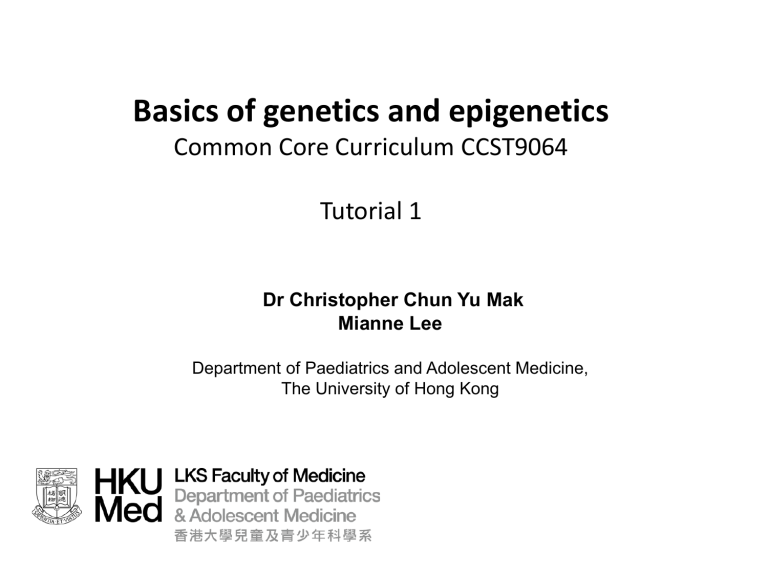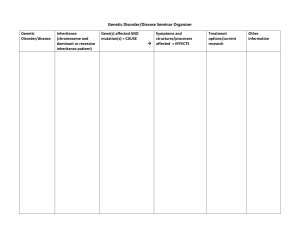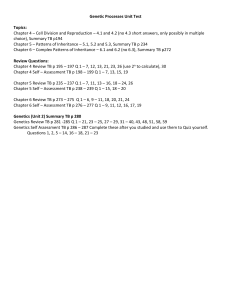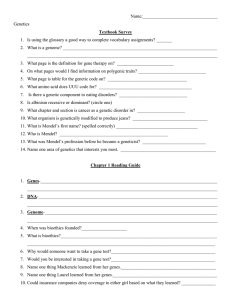
Basics of genetics and epigenetics Common Core Curriculum CCST9064 Tutorial 1 Dr Christopher Chun Yu Mak Mianne Lee Department of Paediatrics and Adolescent Medicine, The University of Hong Kong Ice Breaking • Learn from your partner 1. Their name 2. Their major 3. “Assuming this is a dream, and anything is possible. If there was one thing you could change about your life, what would be?” Basic Concepts in Genetics • Preparation for later lectures ✓What is DNA, Chromosome and a gene? ✓What is a mutation? ✓What has changed since the human genome project? ✓Understand the modes of inheritance • To understand the ‘Jargon’ DeoxyriboNucleic Acid Sex Chromosomes Histone Chromatin A Protein Coding Gene (Sequence of nucleotides) Organization of human genome 46 Chromosomes ~22,000 Genes 6,100,000,000 nucleotides No two individuals are “alike” • In healthy Individuals, on average for every 1000 nucleotides there will be 1 single nucleotide variation (0.1%) in their genomic DNA • 6,000,000 to 10,000,000 genetic variations can be found between the genomes of two distinct unrelated individuals • Majority of these difference are “benign” mutations which do not have any phenotype effects 6-10 million Variations or ‘Differences’ What is a mutation? The Human Genome Project (HGP) The work of the Human Genome Project has allowed researchers to begin to understand the ‘blueprint for building a person’. https://ghr.nlm.nih.gov/primer/hgp/description Next Generation Sequencing DNA library sequence DNA oligos coated on the sequencing flow-cell Library amplification Cluster generation Sequencing Next Generation Sequencing labeled nucleotides Images by the courtesy of Liu Hang, BGI. Modified FASTQ Raw Data • >10 GB per exome sequencing sample • ~100 GB per whole genome sample Bioinformatics sequence alignment, variant calling and annotation Raw sequences Bioinformatics sequence alignment, variant calling and annotation Vs Vs Aligned sequences Reference human genome Spot the difference! (identify the variants) Sequence variant The contributions of genetic and environmental factors to human diseases Haemophilia Osteogenesis imperfecta Club foot Pyloric stenosis Dislocation of hip Duchenne muscular dystrophy GENETIC Phenylketonuria Galactosaemia Rare Genetics simple Unifactorial High recurrence rate Peptic ulcer Diabetes Tuberculosis ENVIRONMENTAL Spina bifida Ischaemic heart disease Ankylosing spondylitis Common Genetics complex Multifactorial Low recurrence rate Scurvy Classification of genetic disorders • Multifactorial + environment • Single gene Male • Chromosomal • Mitochondrial • Somatic mutations (cancer) Single Gene Disorders -Mendelian inheritance • Disorders caused by mutation of one or both copies of a gene • These disorders are inherited in one of several simple patterns – Autosomal – if they are encoded by genes on one of the 22 pairs of autosomes • Autosomal dominant: if the disorder is expressed in a heterozygote (person with one mutant and one normal copy of the gene) • Autosomal recessive: if the disorder is manifested only in a homozygote (a person with two mutant copies of the gene) – X-linked if encoded by a gene on the X chromosome Dominant Heterozygotes with one copy of the altered gene are affected Recessive Homozygotes with two copies of the altered gene are affected X-linked recessive Males with one copy of the altered gene on the X-chromosome are affected Male Documenting the inheritance of a disease or trait is done using a pedigree: http://www.usd.edu/med/som/genetics/curriculum/2BHIST2.htm Documenting the inheritance of a disease or trait is done using a pedigree: https://sites.google.com/a/wyckoffschools.org/genetics-challenge/2-pedigree-analysis Practice drawing a simple pedigree • 14 year old male (at the bottom and center of the pedigree) – Affected by a specific disease (phenotype) • Parents are not related (Not siblings/ cousins) – Mother: 45 y/o mother healthy – Father: 50y/o Affected. • Siblings: 2 sisters (16 and 8 y/o) and 1 brother (8 y/o), all healthy. • The 8 year old younger sister and brother are dizygotic (non-identical) twins Get a pen and paper to draw the pedigree Practice drawing a simple pedigree • 14 year old male • (at the bottom and center of the pedigree) – Affected by a specific disease (phenotype) • Parents are not related • (Not siblings/ cousins) – Mother: 45 y/o mother healthy – Father: 50y/o Affected. • Siblings: 2 sisters • (16 and 8 y/o) and • 1 brother (8 y/o), all healthy. • The 8 year old younger sister and brother are dizygotic (nonidentical) twins Share your Pedigree with the Class Practice Pedigree 50 8 Affected 45 14 16 For medical professionals • 14 year old male referred for evaluation because of tall stature, long limbs, stretch marks on abdomen and back, dilated aortic root and eye lens dislocation. • Parents are not related • Siblings: 2 sisters (16 and 8 y/o) and 1 brother (8 y/o), healthy. • Mother: 45 y/o mother healthy. Three siblings (2 brothers, 1 sister) each has 2 children, all healthy. • Maternal grandmother had breast cancer diagnosed at 60 years of age. Family is from Irish descent • Father: 50y/o, tall and thin, hx heart murmur and some vision problems. 1 sister. • Paternal grandfather had a heart murmur. He died of ruptured aortic aneurism at age 48. Described as tall and thin, with vision problems since childhood. German descent Pedigree German Irish 50 8 Tall and thin Heart murmur 2 45 14 Stretch marks Lens dislocation 16 2 Breast Cancer 2 Autosomal dominant inheritance Principles of Medical Genetics, 2nd ed. 1998 Fig. 3.3 • inheritance is ‘vertical’ – passed from one generation to the next in a vertical fashion • both males and females affected • both males and females can transmit the trait • each affected individual has one affected parent* *exception – de novo mutations Marfan syndrome (Clinical) – Ghent criteria Thumb sign Pectus carinatum Wrist sign Pectus excavatum Lens subluxation Protusio acetabulae Pes planus Aortic root dilatation Lancet 2005;366:1965-76 MJA 2006;184:627-631 Counselling on AD inheritance Another way to present it to a family D=Disease causing n=Unchanged gene Autosomal recessive inheritance • inheritance is ‘horizontal’ – affected individuals tend to be limited to a single sibship • disease not found in multiple generations • both males and females affected • parents of affected child are usually normal but heterozygous for the mutant allele Autosomal recessive inheritance Cystic Fibrosis Major Phenotypic Features • Progressive pulmonary disease • Exocrine pancreatic insufficiency • obstructive azoospermia • elevated sweat chloride • growth failure • meconium ileus (intestinal obstruction) Disease Etiology • caused by mutations in the CF transmembrane conductance regulator gene (CFTR) • occurs among all races; predominance in northern Europeans with incidence of ~1 in 2500 Counselling on AR inheritance Another way to present it to a family X-Linked inheritance • caused by mutant genes on the X chromosome • males – have only a single X chromosome and are affected • females – have two X chromosomes; recessive X-linked disorders are rarely expressed in females X-linked inheritance Duchenne Muscular Dystrophy Major Phenotypic Features • age of onset – childhood • muscle weakness • calf hypertrophy • moderate intellectual compromise • elevated serum creatine kinase levels Disease Etiology • caused by mutations in the DMD gene • incidence ~1 in 3500 male births Duchenne Muscular Dystrophy Pathogenesis • absence of the dystrophin protein alters structural and biochemical properties of skeletal muscle • if the mutation allows some production of the DMD protein, the clinical features are milder (called Becker Muscular Dystrophy) Immunofluorescence microscopy staining with an antibody specific to dystropin Genetics in Medicine 6th ed. 2001 Fig.12-15 X-linked inheritance-for families Break Penetrance • • Concept referring to the all or none expression of a mutant genotype. Usually refers to dominant traits in heterozygotes. If a condition is expressed in less than 100% of persons who carry the responsible allele, it is said to have reduced penetrance – eg. 70% of people with the mutant allele express symptoms of the condition, it is said to be 70% penetrant Expressivity Expressivity is the extent to which a genetic condition is expressed – if there is variable expressivity, the condition may vary from mild to severe, but is never completely unexpressed in individuals who have the mutant allele Questions? Inheritance Autosomal Dominant Penetrance Expressivity X-linked Recessive The Genetic Blueprint for Development Parent’s Health/Wellbeing Pre-pregnancy Pregnancy Environment Environment in Infancy/Childhood Health Learning Genetic Blueprint for Development Quality and timing of early environments shape a child’s future potential Behavior Advancing Early Childhood Development: from Science to Scale Twins Epigenetic marks change gene expressions Epi- above Epigenetic: controls above DNA level Controls whether the gene will be expressed (0 or 100%); or to what degree it is expressed (e.g. 30% or 80%) Times Magazine. January 2010. There are >3 types of epigenetic marks “Tags” located on the genes/ chromosomes Epigenetic Tags ON OFF Relaxed Tightened Silenced Factors affecting epigenetic marks Epigenetic marks are modifiable The Genetic Blueprint for Development Environmental Parent’s Health/Wellbeing Pre-pregnancy Pregnancy Environment Environment in Infancy/Childhood Health Learning Genetic Blueprint for Development Quality and timing of early environments shape a child’s future potential Behavior Advancing Early Childhood Development: from Science to Scale Pregnancy What factors can influence the fetus? Dutch Hunger Winter – experiment on the effects of malnutrition at pregnancy on subsequent adult health Transgenerational effect F1 F2 Higher risk of obesity, cardiovascular disease, diabetes, high blood pressure Carey N. The epigenetics revolution : how modern biology is rewriting our understanding of genetics, disease and inheritance. 2012. Dynamic function of Fixed DNA Survival adaptation? Hypothesis: If the mother has an inadequate diet then it signals the fetus that the living condition in the long term will be impoverished. Consequently, the fetus adapts by changing metabolism to prepare for food shortages after birth F1 F2 Higher risk of obesity, cardiovascular disease, diabetes, high blood pressure Carey N. The epigenetics revolution : how modern biology is rewriting our understanding of genetics, disease and inheritance. 2012. Environment and Epigenetics • How many such changes can be passed on to other generations and for how long these changes persist remains unclear. Summary • Epigenetic marks dynamically reprograms gene expression • Epigenetic marks of the baby are modifiable during pregnancy • Epigenetic marks can also pass on to future generations The Genetic Blueprint for Development Parent’s Health/Wellbeing Pre-pregnancy Pregnancy Environment Environment in Infancy/Childhood Health Learning Genetic Blueprint for Development Quality and timing of early environments shape a child’s future potential Behavior Advancing Early Childhood Development: from Science to Scale What we learn from behavior of rats Reprogramming of the ‘genes’ through maternal behavior Core Concepts of Development 1. Human development is shaped by a dynamic and continuous interaction between biology and experience. 2. Culture influences every aspect of human development and is reflected in childrearing beliefs and practices designed to promote healthy adaptation. 3. The growth of self-regulation is a cornerstone of early childhood development that cuts across all domains of behavior. 4. Children are active participants in their own development, reflecting the intrinsic human drive to explore and master one’s environment. 5. Human relationships, and the effects of relationships on relationships, are the building blocks of healthy development. The Marshmallow Experiment The growth of self-regulation Positive correlation with how well they do in school and even BMI Is self-control genetic? How will children turn out to be? Genetics? Nature? Epigenetics? or Nurture? Assessments 2. Group Presentations (25%) • For this group assignment, students are to work in groups of 2-3 to produce a 9-12 minute presentation on one of the five assigned topics and present in one of the tutorial sessions. • The purpose of this presentation is to assess the student’s ability to independently perform literature search on a given topic and be able to teach others in a concise manner, focusing on the key points. • Format: PowerPoint aided presentation • Time limit: Groups of two (Max 9 mins), Groups of three (Max 12 mins) Assessments 2. Group Presentations (25%) Grouping for the presentation will be assigned by the tutor: Tutorial 2 Topic 1: Genetics and the workplace Will the advancement in the scientific understanding of our genetic code lead to discrimination at the workplace? What is the impact and how has the society adapted to the availability of genetic tests? Topic 2: DNA in films Genetics is a common topic in movies. By use of more than one example, try and use the concepts in movies to elaborate on and predict how genomic technologies may affect the future trends of the world. What are the fundamental values of the world that may change? Topic 3: Eugenics and the future The idea of predicting the talents of the next generation using genetics is growing and selection for genetic traits may be possible in the future as preimplantation genetic diagnosis is already possible for debilitating disorders. What are the long-term impacts on human society as we know it? e.g. Will the story of “Brave New World” by Aldous Huxley become a reality? Topic 4: Genome Editing Technologies What are the latest developments in genome editing technologies and how will this impact our future societies? What are the potential benefits and ethical concerns? Topic 5: Pharmacogenomics Pharmacogenomics is the study of how genetics can influence a person's response to medications. How will this affect medicine as we know it, and what are the broader implications e.g. profitability of ‘tailor-made’ drugs. Assessments 2. Group Presentations (25%) • Assessment Criteria – – – – Delivery (30%) Originality (20%) Educational Value (20%) Q&A Response (30%) End of Tutorial 1 Thank you!






